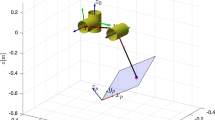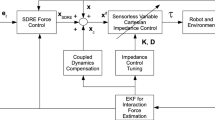Abstract
This paper presents the analysis of bilinear force/position control (BFC) schemes for the guaranteed force tracking performance of a robot manipulator under unknown environment. Borrowing the concept of impedance force control and hybrid force control, BFC schemes are formulated by combining two force control algorithms. The proposed BFC scheme guarantees the desired force/position tracking performance for any environment with the help of a model-based control method by achieving independent axis control. Guaranteed force tracking control performances of three different bilinear functions are presented and analysed. Their performances are tested and compared without knowing any information on the environment such as position and stiffness a priori. Simulation studies of BFC tracking performances for a robot manipulator to follow the sinusoidal trajectory while regulating a desired force on the environment are performed to verify the practical force tracking control performance.
Similar content being viewed by others
References
M. Raibert and J. J. Craig, “Hybrid position/force control of manipulators,” ASME Journal of Dynamic Systems, Measurements, and Control, vol. 102, pp. 126–133, 1981.
N. Hogan, “Impedance control: An approach to manipulator, Part I, II, III,” ASME Journal of Dynamics Systems, Measurements, and Control, vol. 3, pp. 1–24, 1985.
H. Seraji, “Adaptive admittance control: An approach to explicit force control in compliant motion,” Proc. of IEEE Conference on Robotics and Automations, pp. 2705–2712, 1994.
Z. Li, B. Huang, Z. Ye, M. Deng, and C. Yang, “Physical human-robot interaction of a robotic exoskeleton by admittance control,” IEEE Transactions on Industrial Electronics, vol. 65, no. 12, pp. 9614–9624, 2018.
G. Kang, H. S. Oh, J. K. Seo, U. Kim, and H. R. Choi, “Variable admittance control of robot manipulators based on human intention,” IEEE/ASME Transactions on Mechatronics, vol. 24, no. 3, pp. 1023–1032, 2019.
S. Jung, “Admittance force tracking control schemes for robot manipulators under uncertain environment and dynamics,” International Journal of Control, Automation, and Systems, vol. 19, no. 11, pp. 3753–3763, 2021.
R. J. Anderson and M. W. Spong, “Hybrid impedance control of robot manipulators,” IEEE Journal of Robotics and Automation, vol. 4, no. 5, pp. 549–556, 1988.
E. J. Lee, J. Y. Park, K. A. Lopro, C. B. Schradar, and P. H. Jang, “Bang-bang impact control using hybrid impedance/time-delay control,” IEEE/ASME Transactions on Mechatronics, vol. 8, no. 2, pp. 272–277, 2003.
H. Cao, X. Chen, Y. He, and X. Zhao, “Dynamic adaptive hybrid impedance control for dynamic contact force tracking in uncertain environments,” IEEE Access, vol. 7, pp. 83162–83174, 2019.
M. M. Rayguru, M. R. Elara, B. F. Gomez, and B. Ramalingam, “A time delay estimation based adaptive sliding mode strategy for hybrid impedance control,” IEEE Access, vol. 8, pp. 155352–155361, 2020.
C. C. Beltran-Hernandez, D. Petit, I. G. Ramirez-Alpizar, T. Nishi, S. Kikuchi, T. Matsubara, and K. Harada, “Learning force control for contact-rich manipulation tasks with rigid position-controlled robots,” IEEE Robotics and Automation Letters, vol. 5, no. 4, pp. 5709–5716, 2020.
S. Jung and T. C. Hsia, “A new neural network impedance force control of robot manipulators,” IEEE Transactions on Industrial Electronics, vol. 45, no. 3, pp. 451–461, 1998
Z. Xu, S. Li, X. Zhou, S. Zhou, T. Cheng, and Y. Guan, “Dynamic neural networks for motion-force control of redundant manipulators: An optimization perspective,” IEEE Transactions on Industrial Electronics, vol. 68, no. 2, pp. 1525–1536, 2021.
M. P. Polverini, S. Formentin, L. Merzagora, and P. Rocco, “Mixed data-driven and model-based robot implicit force control: A hierarchical approach,” IEEE Transactions on Control Systems Technology, vol. 28, no. 4, pp. 1258–1271, 2020.
S. Jung and T. C. Hsia, “Adaptive force tracking impedance force control of robot for cutting process,” Proc. of IEEE Conference on Robotics and Automations, pp. 1800–1805, 1999.
S. Jung, T. C. Hsia, and R. G. Bonitz, “Force tracking impedance control of robot manipulators under unknown environment,” IEEE Transactions on Control Systems Technology, vol. 12, no. 2, pp. 474–483, 2004.
S. Jung, T. C. Hsia, and R. G. Bonitz, “Force tracking impedance control for robot manipulators with an unknown environment: Theory, simulation, and experiment,” The International Journal of Robotics Research, vol. 20, no. 9, pp. 765–774, 2001.
S. Baek, J. Baek, W. Kwon, and S. Han, “An adaptive model uncertainty estimator using delayed state-based model-free control and its application to robot manipulators,” IEEE/ASME Transactions on Mechatronics, vol. 27, no. 6, pp. 4573–4584, 2022.
M. Sarajchi, M. K. Al-Hares, and K. Sirlantzis, “Wearable lower-limb exoskeleton for children with cerebral palsy: A systematic review of mechanical design, actuation type, control strategy, and clinical evaluation,” IEEE/ASME Transactions on on Neural Systems and Rehabilitation Engineering, vol. 29, pp. 2695–2720, 2021.
Author information
Authors and Affiliations
Corresponding author
Ethics declarations
The author declares that there is no competing financial interest or personal relationship that could have appeared to influence the work reported in this paper.
Additional information
Publisher’s Note Springer Nature remains neutral with regard to jurisdictional claims in published maps and institutional affiliations.
This work was supported by the Chungnam National University Grant.
Seul Jung received his B.S. degree in electrical and computer engineering from Wayne State University, USA in 1988, and his M.S. and Ph.D. degrees in electrical and computer engineering from the University of California, Davis, in 1991 and 1996, respectively. In 1997, he joined the Department of Mechatronics Engineering, Chungnam National University, where he is presently a professor. His research interests include intelligent mechatronics systems, intelligent robotic systems, mobility, gyroscope applications, and robot education.
Rights and permissions
About this article
Cite this article
Jung, S. Analysis of Bilinear Force Tracking Control for Robot Manipulators Under Unknown Environment. Int. J. Control Autom. Syst. 21, 4006–4014 (2023). https://doi.org/10.1007/s12555-023-0161-9
Received:
Revised:
Accepted:
Published:
Issue Date:
DOI: https://doi.org/10.1007/s12555-023-0161-9




